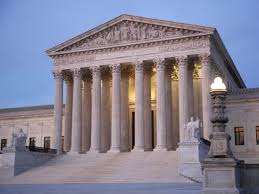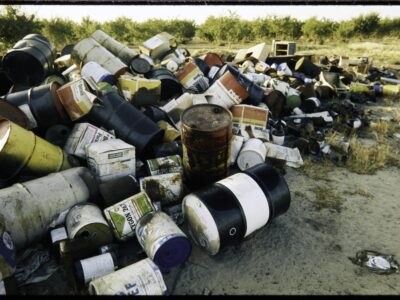The U.S. Supreme Court’s Most Important 2020 Environmental Law Decisions
Clean Water Act, CERCLA, Native American Law and Trump’s Border Wall Lead the List
 It’s become customary for critics and observers from many disciplines to publish a wide variety of lists at year’s end, nominating the most important or best movies, music, plays, etc. of the preceding year. Why not follow that tradition in the fields of environmental law and policy?
It’s become customary for critics and observers from many disciplines to publish a wide variety of lists at year’s end, nominating the most important or best movies, music, plays, etc. of the preceding year. Why not follow that tradition in the fields of environmental law and policy?
With that objective in mind, I plan over the next few days to offer my lists of the most consequential environmental law decisions of 2020 from the U.S. Supreme Court, the U.S. Court of Appeals for the Ninth Circuit and the California Supreme Court. In this post I’ll start with the U.S. Supreme Court.
One important caveat up front: the lists that follow below and later this week are inherently subjective. I welcome your comments and criticisms, as well as your own nomination of environmental law cases that you believe should have been on my 2020 “most important environmental law decisions” lists.
In 2020 perhaps the most consequential Supreme Court developments did not involve any particular cases from what was not a blockbuster Term. Rather, public and media attention understandably focused on the passing earlier this year of the iconic Justice Ruth Bader Ginsburg; President Trump’s nomination and the subsequent, stormy Senate confirmation proceedings culminating in Justice Amy Coney Barrett’s ascension to the High Court; and speculation as to how the changes in justices and the ideological makeup of the Court will affect Supreme Court jurisprudence prospectively.
But the Supreme Court did in fact issue several important environmental law decisions–and one key order–in 2020. They’re listed and briefly discussed below:
County of Maui v. Hawaii Wildlife Fund
The environmental law non-profit organization Earthjustice characterized the Supreme Court’s April 2020 County of Maui decision–perhaps a tad hyperbolically–as “the Clean Water Act case of the century.” But that decision is indeed significant and, indeed, probably constitutes the Court’s most consequential environmental law decision of 2020. The issue in the case was whether effluent from a sewage treatment plant that’s injected into groundwater wells but ultimately migrates into navigable waters (in County of Maui, the Pacific Ocean) constitutes a “discharge” of pollutants requiring a permit from federal or state authorities under the CWA. The environmental organization bringing the suit contended that a permit is always required under such circumstances to avoid a major circumvention of CWA regulatory jurisdiction. The County of Maui (supported by the Trump Administration), on the other hand, argued that the intervening injection of treated sewage effluent into groundwater aquifers necessarily and fully removes such discharges from CWA permit jurisdiction.
In a 6-3 decision authored by Justice Stephen Breyer, the Court rejected the absolutist positions of both sides and, instead, adopted a middle ground, fact-based rule. Specifically, the justices held that the CWA requires a permit for any discharge from a sewage treatment plant or comparable industrial facility into groundwater wells when there exists the “functional equivalent” of a direct discharge from a point source into navigable waters.
Providing further guidance to lower courts and litigants, the majority indicated that “[m]any factors may be relevant to determining whether a particular discharge is the functional equivalent of one directly into navigable waters.” The Court opined that “[t]ime and distance will be the most important factors in most cases,” but offered up a non-exclusive list of additional factors it directed lower courts to analyze and apply. The justices remanded the case to the courts below to apply its newly-announced rule to the facts in County of Maui.
County of Maui plugs a major loophole in Clean Water Act jurisdiction, represents a major victory for environmental interests but, going forward, injects another fact-based, multifactor analysis into the often complex and contentious issue of determining jurisdictional limits under the CWA.
Atlantic Richfield Co. v. Christian.
Atlantic Richfield Co. involves the federal Comprehensive Environmental Response, Compensation, and Liability Act, better known as the Superfund Law. The specific dispute concerned the largest Superfund site in the nation, the century-old Anaconda copper mine and smeltering site in Montana. Since 1983, USEPA and the site owner, Atlantic Richfield Company (ARCO), have been undertaking a massive cleanup plan to remediate the contaminated site. Adjacent Montana private landowners, displeased with EPA’s remediation efforts, sued ARCO in state court, alleging state common law theories and seeking $58 million to pursue their own remediation plan.
Before the Supreme Court, Atlantic Richfield raised two key issues: 1) whether the landowners could sue ARCO in state court seeking damages under state law, notwithstanding CERCLA’s complex federal liability and remediation structure; and 2) if the landowners are required under CERCLA to obtain EPA approval before forcing ARCO to fund remedial actions more stringent than those required by EPA under its required cleanup plan.
The justices’ Solomonic decision in Atlantic Richfield held that the landowners could pursue their state common law remedies against ARCO seeking money damages to remediate their properties notwithstanding CERCLA’s complex statutory scheme governing contaminated site cleanups. But the Court further declared that under CERCLA the landowners were themselves potentially responsible parties (PRPs) who are required to obtain prior EPA approval before initiating remedial actions on their own properties.
Going forward, the first portion of the Court’s ruling may prove the most consequential. Besides clarifying CERCLA’s regulatory scope, the justices’ holding that state courts retain jurisdiction to impose liability under state common law theories notwithstanding CERCLA’s mandates may well have relevance in other contexts. For example, there are numerous currently-pending lawsuits across the nation in which state and local governments are pursuing damage claims against major oil, gas and coal companies for climate change-induced harm they have suffered. The energy defendants in those cases assert such state law claims and remedies are displaced by the federal Clean Air Act.
McGirt is not an environmental case at all but, rather, involves federal vs. state criminal law jurisdiction over Native Americans for crimes committed on tribal lands. Nevertheless, the Supreme Court’s ruling in McGirt may well have major ramifications for natural resources and environmental law in the future.
McGirt concerned a Native American’s challenge to his conviction of serious crimes under Oklahoma state law. McGirt argued that under the federal Major Crimes Act, he could only be prosecuted in federal court for any crimes committed in “Indian Country.” (Most of eastern Oklahoma consists of Native American reservations created under 19th century treaties between the tribes and the federal government.) In McGirt, a 5-4 majority of the Court agreed, finding state criminal law inapplicable on tribal lands.
McGirt‘s significance to natural resources law and lawyers lies not in its facts or specific holding, but in the decision’s implications in a host of non-criminal law contexts. For example, the ability of states to regulate Native American water, fishing and hunting rights on tribal lands in the future appears questionable at best, given the broad language of the McGirt decision. What is certain is that the decision’s impact will resonate far beyond Oklahoma’s borders, since many other Western states similarly include substantial areas of tribal lands. Time will determine the ultimate scope of the Court’s below-the-radar ruling in the case. Notably, however, McGirt is the latest in a series of recent Supreme Court decisions reflecting a more sympathetic attitude toward the rights of Native Americans than the Court had displayed in previous eras.
(One interesting Supreme Court backstory regarding McGirt: Justice Gorsuch authored the majority opinion, joined by the four progressives then on the Court, The only Westerner currently on the Court, Gorsuch’s opinion reveals significant empathy for the injustices historically visited upon Native Americans by federal and state governments alike. Conversely, Chief Justice John Roberts found himself in dissent in McGirt–the only case from the Court’s entire 2019-20 Term in which Roberts was not in the majority.)
Trump v. Sierra Club
Finally, a major Supreme Court ruling with significant environmental consequences took the form of an order containing precisely seven words. That ruling relates to President Trump’s ongoing efforts to construct a wall along the southern border of the U.S. to deter undocumented aliens from entering the country. (The State of California and environmental groups have filed several lawsuits challenging the border wall project, claiming that if constructed the wall will have numerous adverse environmental impacts.).
When Congress failed to appropriate funds Trump had requested to fund the wall’s construction, the President went to Plan B: he diverted millions of dollars from Congress’ 2019 Department of Defense Appropriations Act to underwrite building of the border wall. The Sierra Club, California and a number of other states promptly sued, arguing that the Appropriations Act did not authorize the President’s unilateral transfer of Congressionally-appropriated funds, and that the diversion violates fundamental separation of powers principles under the U.S. Constitution. Both the U.S. district court and Ninth Circuit Court of Appeals agreed, enjoining the President’s expenditure of the diverted funds for border wall construction purposes. However, this past July a 5-4 majority of the Supreme Court lifted the injunction, effectively allowing the Trump Administration to spend the diverted Pentagon funds for border wall construction while the litigation proceeds on the merits of the transfer. This past October, the justices granted the Trump Administration’s petition for certiorari, and the case will be argued and decided early in 2021.
So what’s the significance of the Supreme Court order lifting the lower courts’ injunction?
The answer is found in Justice Stephen Breyer’s dissent from the Court’s staying of the injunction: Breyer aptly notes that the majority’s brief order “may operate, in effect, as a final judgment” because the challenged funds can and likely will be expended by the Trump Administration before the substantive merits of the Sierra Club case can be resolved by the justices next year. Recent news reports confirm that fact: in its final weeks, the Trump Administration is working feverishly to spend as much of its diverted DOD funding as possible before January 20th. The related, political motivation in doing so, of course, is to prevent the incoming Biden Administration from reversing course and revoking Trump’s transfer of Congressionally-appropriated DOD funds for the border wall.
In conclusion, the Supreme Court’s key environmental law decisions in 2020–with the notable exception of the Trump v. Sierra Club order, reveal a moderate trend. In both County of Maui and Atlantic Richfield, the justices hewed to a middle ground approach that, if anything, tilted more toward environmental than development interests. And in McGirt, the Court issued a decision that could potentially be transformative when it comes to natural resource management in Indian Country.
Going forward, the key question is whether, with a firm, five-member conservative majority in place, the Supreme Court will continue to pursue a moderate course in its environmental docket or, alternatively, lurch dramatically rightward. We’ll be better able to answer that question a year from now.
Tomorrow: 2020’s most important environmental law decisions from the U.S. Court of Appeals for the Ninth Circuit.
Reader Comments
One Reply to “The U.S. Supreme Court’s Most Important 2020 Environmental Law Decisions”
Comments are closed.







Thanks for this and the Ninth Circuit and Cal Supreme Court summaries. All clear and succinct. Much appreciated.